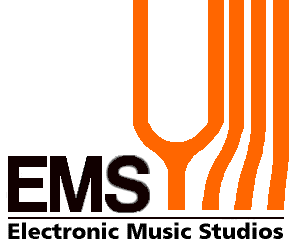
A Guide to the EMS Product Range
1969 to 1979
by Graham Hinton
Last updated: 17 June 2001

Last updated: 17 June 2001
"... There are a number of people in the field that I have a lot of respect
for. There's people like Peter Zinovieff, one of the unsung heroes in the
synthesis world who's behind EMS and all their things. Most people don't
realise how heavy his equipment is, they don't know how to use it. .."
Malcolm Cecil, interviewed in "Synapse" 1976.
Most of the photos are black and white originals and have been scanned as
a 256 colour greyscale. They are best viewed the same.
Click on the small images to view the full high resolution ones.
[Key to prices: (Price when introduced) 1979 Price]
London geography lesson: Peter Zinovieff lived in Putney, David Cockerell lived in Cricklewood, the BBC Radiophonic Workshop was located in Delaware Road and Portabello Road was (and still is) a fashionable market.
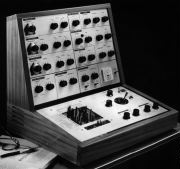 VCS3.GIF (207K)
VCS3.GIF (207K)
![]() VCS4
VCS4
1969. Not produced.
Designer: David Cockerell.
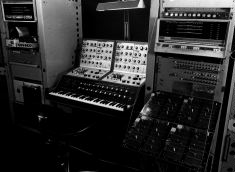 VCS4.GIF (277K)
VCS4.GIF (277K)
A "Live Performance Module" comprising two VCS3s side by side with a keyboard, mixer and signal processing in
front all in a single wooden cabinet. There was only one prototype built, lost track of in 1983, but now known to be in the USA.
![]() DK1 (aka The Cricklewood)
DK1 (aka The Cricklewood)
1969. (£145)
Designer: David Cockerell.
Velocity sensitive "Dynamic" monophonic Keyboard for use with VCS3.
Included an extra VCO and VCA.
![]() Synthi KB1
Synthi KB1
1970. (£330) Not produced.
Designer: David Cockerell.
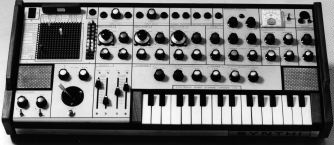 KB1.GIF (353K)
KB1.GIF (353K)
The same circuit modules as the VCS3 housed in a different case with a 29 note
miniature keyboard, Prototype sold to Yes.
![]() Synthi 100 (formerly Digitana, aka the
Delaware)
Synthi 100 (formerly Digitana, aka the
Delaware)
1971. (£6,500) £35,000
Designer: David Cockerell.
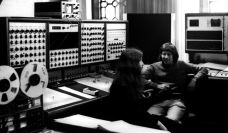 SYNTHI100.GIF (224K)
SYNTHI100.GIF (224K)
Synth100 (heavily modified) with Computer Synthi (1977)
The same technology as the VCS3, but built into a very large console patched with
two 60 x 60 matrix boards, one for the signals and one for control voltages.
Module complement:
<40 built. Sold mainly to Universities and radio stations, the most famous and overworked model belonged to the BBC Radiophonic Workshop and was the main synthesizer used throughout the 70s. Listen to their special showcase program "The Space Between", the original Hitchhikers' Guide to the Galaxy radio series or any John Pertwee vintage Dr. Who episodes.
Several of the devices were packaged separately as small wooden sleeved units:
![]() Sequencer 128 (also 32 and 64 versions)
Sequencer 128 (also 32 and 64 versions)
1971. (£135)
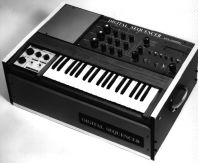 DIGSEQ.GIF (187K)
DIGSEQ.GIF (187K)
Prototype of what became the Sequencer 256
Peter Zinovieff and Tristam Cary walked into the Moog Trumansberg factory with this and
just plugged it in, to much surprise and annoyance - their sequencer could only do 8 steps.
![]() Synthi Sequencer 256 (formerly Synthi Moog
Sequencer)
Synthi Sequencer 256 (formerly Synthi Moog
Sequencer)
1971. (£1,100)
Designer: David Cockerell.
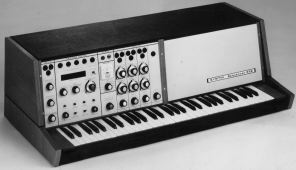 SEQ256.GIF (346K)
SEQ256.GIF (346K)
Separate version of the Synthi 100 sequencer.
![]() The other VCS4
The other VCS4
1971. Not produced.
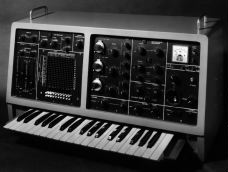 NOTASA.GIF (240K)
NOTASA.GIF (240K)
A design study for a follow up to the VCS3 case containing the same boards.This was believed lost until it recently appeared in Sound on Sound Oct 97/p190. When this was being considered some engineers from the EMS factory arrived carrying a briefcase which turned out to be the prototype Synthi A. There was no contest.
![]() Synthi A (formerly Portabella)
Synthi A (formerly Portabella)
1971. (£198)
Designer: David Cockerell.
Industrial Design: Gerry Rogers.
Same specification and pcbs as the VCS3, but fitted in an attache briefcase.
(Yes, it actually is a Spartanite one.)
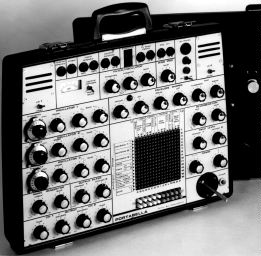 PORTABEL.GIF (483K)
PORTABEL.GIF (483K)
The prototype Synthi A. Note the name, the meter and the lid loudspeaker.
![]() Synthi AKS
Synthi AKS
1972. (£420) £1,452
Designer: David Cockerell.
Synthi A with a KS sequencer in the lid.
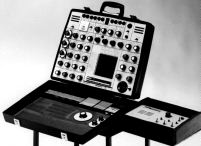 SYNTHIA.GIF (204K)
SYNTHIA.GIF (204K)
Synthi A with original K and Sequencer32
The first 30 Synthi AKs featured a black and silver Touch pad,
Spin-and-touch random note selector and an unplayable resistive touch sensitive
keyboard. This was replaced by the familiar blue capacitive touch sensitive
keyboard with integrated sequencer.
![]() DK2
DK2
1972. (£145) £472
Designer: David Cockerell.
"Duophonic" version of DK1.
![]() DKS
DKS
1972. Not produced.
Designer: David Cockerell.
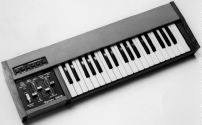 DKS.GIF (162K)
DKS.GIF (162K)
A mechanical keyboard version of the KS sequencer.
![]() KS
KS
1972. (£164)
Designer: David Cockerell.
The sequencer from the Synthi AKS available separately.
![]() Synthi Hi-Fli (formerly Sound Freak)
Synthi Hi-Fli (formerly Sound Freak)
1973. (£180) £308
Designer: David Cockerell.
Industrial Design: Martin Holbrook.
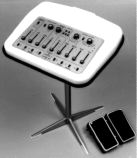 HIFLI.GIF (128K)
HIFLI.GIF (128K)
A guitar treatment unit built as a console on a stand with two pedal
controllers which could be routed as control voltages to any of the slider functions.
Main Controls and Effects (Left to right on control panel)
Mains powered: 100-135 or 200-260 Vac
Input Signal: 10mV (min) to 3V (max), 100kohm impedance.
Output Signal: -20dbm (min) to 0dbm (max).
![]() Synthi VCS3 II
Synthi VCS3 II
1973. (£374) £1,268
Designer: David Cockerell.
Prestopatch added, matrix layout and some circuitry changed, otherwise same as
VCS3 Mk I.
![]() 32 x 32 Matrix
32 x 32 Matrix
1974. (£450)
Designer: David Cockerell.
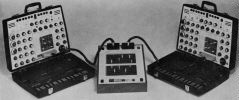 32X32.GIF (197K)
32X32.GIF (197K)
Patchboard for interconnecting two VCS3s or Synthi As by plugging into the
Prestopatch sockets.
![]() 49 x 49 Matrix
49 x 49 Matrix
1974. (£583)
Designer: David Cockerell.
Larger version of above with keyboard sockets.
![]() Synthi P
Synthi P
1974. Not produced.
Designer: David Cockerell.
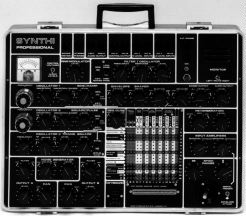 SYNTHIP.GIF (349K)
SYNTHIP.GIF (349K)
A MkIII "Professional" version with improved Oscillators, Filter and Envelope.
Only 3 prototypes made, 2 in this form with bronze finish, the other in
standard Synthi A case and styling.
![]() Speech Synthesizer
Speech Synthesizer
1974. Not produced.
Designer: David Cockerell.
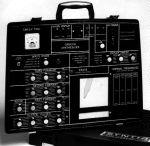 SYNTHIS.GIF (127K)
SYNTHIS.GIF (127K)
Prototype with graphic Formant entry (drawn with a ballpoint pen!).
![]() Spectron (formerly Spectre)
Spectron (formerly Spectre)
1974/5. (£4,000)
Designer: Richard Monkhouse.
 SPECTRE.GIF (198K)
SPECTRE.GIF (198K)
The prototype was used to provide a projected lightshow for an early Tangerine
Dream concert at the London Rainbow.
15 Built.
![]() Computer Synthi
Computer Synthi
1975/6. (£15,000, software extra)
Designer: Peter Eastty.
An add-on to the Synthi 100 interfaced to the control matrix board via two 24 x
60 matrix boards. Complement:
3 Built.
![]() Synthi E
Synthi E
1975. (£200) £558
Designer: Tim Orr
A low cost "Educational" synthesizer in briefcase format.
![]() Synthi DKE
Synthi DKE
1975. £200
Designer: Tim Orr
A 3 octave mechanical keyboard for Synthi E.
![]() QUEG - Quadrophonic Effects Generator
QUEG - Quadrophonic Effects Generator
1975. (£1400)
Designer: Tim Orr.
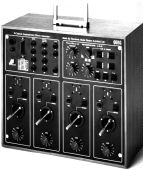 QUEG.GIF (160K)
QUEG.GIF (160K)
Four channel quad surround sound mixer with joystick and quadrature VCO
control. A two channel version was also made fitted into a custom Electrosonic
EMS Mixing Console.
![]() Phase Frequency Shifter
Phase Frequency Shifter
1975. (£400).
Designer: Tim Orr.
Separate version of the one in the Vocoder 5000.
![]() Vocoder 5000 (aka Studio Vocoder)
Vocoder 5000 (aka Studio Vocoder)
1976 (£5,000) £7,165
Designer: Tim Orr.
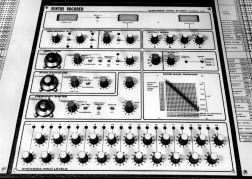 VOCODER.GIF (367K)
VOCODER.GIF (367K)
Custom version built into Synthi 100 for WDR Germany (Stockhausen)
![]() Universal Sequencer
Universal Sequencer
1977. (£700)
Designer: Tim Orr.
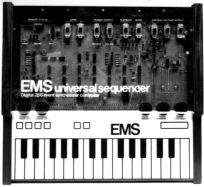 UNISEQ.GIF (250K)
UNISEQ.GIF (250K)
Upgraded KS with Control Voltage and Gate interface.
Few built.
![]() Vocoder 2000
Vocoder 2000
1977. £813
Designer: Tim Orr.
![]() VCS3/Synthi A Upgrade Cards
VCS3/Synthi A Upgrade Cards
1978. Not produced.
Designer: Graham Hinton.
Replacement circuit boards featuring improved VCOs with temperature
compensation and synchronisation, improved VCAs, RM and Reverb.
![]() PolySynthi
PolySynthi
1978. (£700) £1,200
Designers: Peter and Rose Zinovieff, (Delay by David Cockerell)
<30 built.
![]() PolySequencer
PolySequencer
1978. Not produced.
Designers: Peter Zinovieff and Graham Hinton.
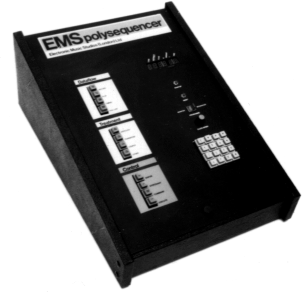
Microprocessor based polyphonic sequencer with up to 10 minutes recording
capacity.
Real time editing and effects.
2 prototypes built.
![]() Return to Electronic Music Studios' Main Page
Return to Electronic Music Studios' Main Page
![]() Go to Graham Hinton's EMS Modifications Page
Go to Graham Hinton's EMS Modifications Page
All material on these pages Copyright ©1995 - 1998 Graham Hinton & Robin Wood.
Most photos are from the EMS Archive and have never been used before.
Synthi is a trademark of Electronic Music Studios.
All manufacturers' trademarks are acknowledged.